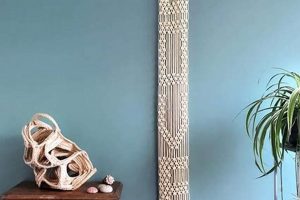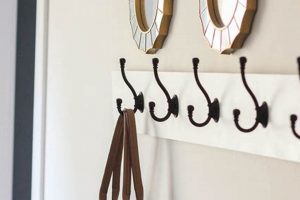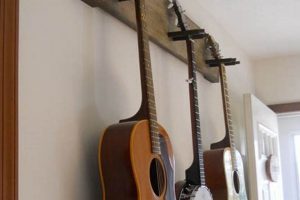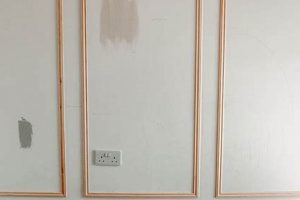A self-constructed climbing structure situated within a residential or commercial building allows individuals to engage in the sport of climbing regardless of external weather conditions or access to natural rock formations. These structures typically consist of a framework of plywood panels attached to a supporting structure, featuring a variety of climbing holds bolted onto the surface to simulate the challenges of natural rock climbing. For example, a homeowner might build such a structure in their garage to facilitate personal fitness and recreational climbing practice.
Building a climbing structure indoors offers numerous advantages. It provides a convenient and accessible means of physical exercise, enhancing strength, coordination, and problem-solving skills. Historically, indoor climbing facilities were initially developed as training grounds for mountaineers but have evolved into popular recreational activities and fitness regimens for a broader population. The controlled environment minimizes exposure to weather-related hazards, promoting consistent training opportunities.
The subsequent sections will detail the essential components, construction methods, safety considerations, and design principles relevant to creating a personalized climbing area. Attention will be given to material selection, structural integrity, and hold placement strategies for optimal user experience and safety.
Construction Guidance
The following guidelines offer crucial insights for successful construction, focusing on safety and structural integrity.
Tip 1: Prioritize Structural Integrity: The supporting framework requires meticulous planning and construction. Employ lumber of sufficient grade and dimensions to withstand anticipated loads. Secure connections with appropriate hardware and follow established engineering principles to ensure stability.
Tip 2: Employ High-Quality Materials: Opt for plywood panels designed for structural applications. The paneling should be of adequate thickness to resist deformation under load. Consider treated lumber for environments with high humidity to prevent decay.
Tip 3: Implement a Secure Attachment System: Climbing holds must be affixed to the panels with bolts and t-nuts designed for this purpose. Ensure that the t-nuts are securely embedded in the plywood, and the bolts are tightened to the manufacturer’s specified torque. Regular inspection and tightening are essential.
Tip 4: Strategically Plan Hold Placement: Consider the intended difficulty and climbing style when positioning holds. Vary the spacing, angle, and type of holds to create diverse routes and challenges. Prioritize placements that minimize the risk of falls and promote controlled movements.
Tip 5: Incorporate Safety Measures: Install adequate padding beneath the climbing area to mitigate the impact of falls. Regularly inspect the padding for wear and tear, and replace it as needed. Implement spotters during climbing sessions, especially for novice climbers.
Tip 6: Adhere to Building Codes: Consult local building codes and regulations before commencing construction. Ensure that the structure complies with all applicable safety standards and requirements. Obtain necessary permits if required.
Tip 7: Regular Inspection and Maintenance: Conduct routine inspections of the structure, including the frame, panels, holds, and attachment hardware. Address any signs of wear, damage, or loosening immediately to prevent accidents.
Adhering to these recommendations enhances structural safety and provides a more enjoyable climbing experience.
The concluding section will summarize key aspects and offer final insights into the overall process.
1. Structural Integrity
Structural integrity is paramount in the context of a self-constructed climbing wall. It directly influences the safety and longevity of the structure. A compromised structural foundation poses significant risks to users. Understanding the principles and facets of structural integrity is therefore critical for anyone undertaking such a project.
- Frame Construction
The supporting framework serves as the backbone of the climbing wall. It must be engineered to withstand substantial dynamic loads exerted during climbing. Insufficient framing can lead to deflection, cracking, or catastrophic failure. Examples include using appropriately sized lumber, properly spaced supports, and secure joinery techniques. The choice of materials (e.g., wood type, steel) and construction methods (e.g., bolting, welding) directly impacts the frame’s capacity to bear weight and resist stress. Neglecting this aspect risks collapse and potential injury.
- Panel Attachment
The method of attaching climbing panels to the frame is crucial for load distribution and stability. Improper attachment can create stress concentrations, weakening the structure. Examples involve using an adequate number of fasteners (screws or bolts), properly spacing them, and ensuring they are securely anchored into both the panel and the frame. Poor panel attachment can result in panel detachment, creating a hazard for climbers. Furthermore, inappropriate use of adhesives or weak fasteners can lead to premature failure.
- Load Distribution
Climbing walls experience dynamic forces concentrated at the hold locations. The design must account for these concentrated loads and distribute them effectively throughout the structure. This can be achieved through strategic framing, panel reinforcement, and hold placement. An unbalanced load distribution can overload specific areas, increasing the risk of failure. Finite element analysis (FEA) can be used to model load distribution and identify potential weak points in the design.
- Material Properties
The materials chosen for the frame, panels, and fasteners must possess adequate strength, stiffness, and durability to withstand the rigors of climbing. Using subpar materials compromises structural integrity. For example, using low-grade plywood or inadequately hardened fasteners can significantly reduce the wall’s load-bearing capacity and lifespan. Understanding material properties, such as tensile strength, yield strength, and shear strength, is essential for making informed material selection decisions. The material selected must factor in the potential for moisture exposure, extreme temperatures, and other environmental concerns.
These facets highlight the interconnected nature of structural integrity in a climbing wall. A holistic approach that considers frame construction, panel attachment, load distribution, and material properties is necessary to ensure a safe and durable climbing structure. A deficiency in any of these areas can undermine the overall integrity, leading to potential hazards. Proper design, construction, and regular inspection are vital for maintaining the structural integrity of a self-constructed climbing wall.
2. Hold Placement
Hold placement is a pivotal element in the design and functionality of a self-constructed climbing structure. The strategic positioning of holds dictates the difficulty, flow, and overall climbing experience. Careful consideration of hold placement parameters transforms a simple structure into a challenging and engaging exercise medium.
- Difficulty Calibration
Hold spacing and orientation directly influence the difficulty of a climbing route. Closely spaced holds generally create easier routes suitable for beginners. Conversely, widely spaced holds demand greater reach, strength, and technique, catering to more experienced climbers. Orienting holds in various directions (e.g., slopers, crimps, jugs) introduces additional complexity. For instance, a series of small, downward-facing crimps spaced far apart constitutes a difficult sequence requiring significant finger strength. The ability to calibrate route difficulty through hold placement is essential for creating a structure that accommodates a range of skill levels.
- Movement Flow and Route Setting
The arrangement of holds shapes the climber’s movement patterns and dictates the flow of the route. A well-designed route encourages natural and fluid movements, promoting efficient climbing technique. Poorly planned hold placements can lead to awkward or strenuous moves, diminishing the climbing experience. Route setters employ various strategies, such as creating dynamic sequences involving jumps or traverses, to challenge climbers and enhance engagement. The strategic use of color-coded holds to delineate specific routes adds another layer of complexity and visual appeal.
- Training Specificity
Hold placement can be tailored to target specific muscle groups or climbing techniques. For example, a concentration of small crimps strengthens finger flexors, while widely spaced slopers develop upper body pulling power. A series of overhanging holds promotes core strength and endurance. By strategically placing holds, climbers can create training circuits designed to address their individual weaknesses and enhance overall performance. This allows for a highly customizable and targeted training experience within the confines of a self-constructed wall.
- Safety Considerations
Hold placement impacts climber safety. Holds positioned too close to the ground can increase the risk of ankle injuries during falls. Conversely, holds placed too high without adequate fall protection pose a threat of more severe injuries. Proper spacing between holds minimizes the likelihood of collisions or awkward falls. The strategic placement of large, easily gripped holds (jugs) near the top of a route provides a secure resting point and reduces the risk of uncontrolled descents. Careful consideration of fall zones and potential hazards is paramount when determining hold placement strategies.
These aspects underscore the critical connection between hold placement and the overall effectiveness of a structure. A thoughtful approach to hold placement transforms a basic climbing surface into a versatile tool for recreation, training, and skill development. Proper planning enhances the climbing experience and minimizes potential safety hazards. Integrating these design principles contributes to a higher-quality climbing wall.
3. Material Selection
The choice of materials constitutes a critical determinant of the structural integrity, safety, and longevity of a self-constructed climbing structure. Inadequate material selection can compromise the entire project, leading to premature failure and potential safety hazards. A thorough understanding of material properties and suitability is therefore essential for a successful outcome.
- Plywood for Climbing Panels
The climbing panels, typically constructed from plywood, form the primary climbing surface. The grade and thickness of the plywood significantly impact its ability to withstand repeated loading and resist deformation. Lower grades may exhibit voids, delamination, or inadequate strength, leading to hold pull-through or panel failure. Recommended options include Baltic birch plywood or structural-grade plywood with a minimum thickness of inch. These materials provide the requisite strength and durability for a safe and reliable climbing surface. An example of improper selection would be the use of OSB (Oriented Strand Board), which lacks the structural integrity required for climbing applications.
- Lumber for Framing
The framing lumber provides the structural support for the climbing panels. The species, grade, and dimensions of the lumber must be sufficient to handle the anticipated loads. Softwoods like pine or fir are commonly used, but higher grades are necessary to ensure adequate strength and resistance to bending or twisting. Proper joint construction, using appropriate fasteners and techniques, is equally important. An example would be using 2×4 lumber for framing when 2×6 lumber is required to meet load-bearing requirements. This can lead to structural instability and potential collapse.
- Climbing Holds and Hardware
Climbing holds and their associated hardware (bolts, t-nuts) must be selected based on quality, durability, and compatibility. Holds should be made from durable materials such as polyurethane or polyester resin, capable of withstanding repeated use and exposure to chalk and sweat. Bolts and t-nuts must be of appropriate size and strength to securely attach the holds to the panels. Stainless steel hardware is recommended for its corrosion resistance. Inferior holds may crack or break under load, while improperly sized or weakened hardware can lead to hold detachment. Regular inspection and replacement of worn or damaged holds and hardware are crucial for maintaining safety.
- Fall Protection Padding
The fall protection padding beneath the climbing area mitigates the risk of injury during falls. The type and thickness of padding must be sufficient to absorb impact and cushion landings. Commonly used materials include closed-cell foam or gym mats. The padding should be of adequate thickness and coverage to provide a safe landing zone. Inadequate padding can result in sprains, fractures, or other injuries. Regular inspection and maintenance of the padding are essential to ensure its continued effectiveness. The use of thin carpet or minimal padding is an inadequate and potentially dangerous solution.
In summary, selecting appropriate materials is a cornerstone of building a secure climbing structure. The examples provided illustrate how specific choices impact the overall safety and performance. From panel materials to hardware, each component plays a vital role in structural integrity. A well-informed material selection process is an essential step in the development process.
4. Safety Measures
The construction of a climbing structure intrinsically introduces potential hazards. Safety measures represent the critical safeguards implemented to mitigate these risks, ensuring user well-being. The absence of adequate precautions directly correlates with an increased incidence of injuries, ranging from minor abrasions to severe fractures or head trauma. The integration of safety protocols is not merely an optional addendum but a fundamental component of constructing a climbing structure. An example of neglecting these precautions includes building a wall without appropriate fall zone padding, thus increasing the risk of impact-related injuries. The practical significance of understanding and implementing safety measures is therefore paramount in minimizing potential harm.
Practical applications of safety measures encompass several key areas. The establishment of a clearly defined and unobstructed fall zone beneath the wall is critical. This area must be free of sharp objects, protrusions, or obstacles that could exacerbate injuries during a fall. Padding, consisting of appropriately thick and impact-absorbent materials, such as closed-cell foam or specialized gym mats, is mandatory. Regular inspection of the wall, including holds, hardware, and structural components, is essential to identify and address any signs of wear, damage, or loosening. Furthermore, the implementation of climbing rules and supervision, particularly for novice climbers, can help prevent accidents arising from improper technique or overestimation of abilities. Another practical application involves the use of spotters who can guide falls and minimize the risk of uncontrolled landings.
In conclusion, a climbing structure inherently necessitates strict adherence to safety protocols. The effective implementation of these measures constitutes the primary defense against potential harm. Understanding the direct cause-and-effect relationship between safety precautions and injury prevention is paramount. The challenges lie in consistently applying these measures and maintaining vigilance in identifying and addressing potential hazards. Ultimately, prioritizing safety transforms a potentially dangerous activity into a challenging and rewarding form of recreation and exercise.
5. Wall Angle
The inclination of the climbing surface, commonly referred to as wall angle, is a primary determinant of the difficulty and training focus of a self-constructed indoor climbing wall. A vertical wall (90 degrees) serves as an entry point for beginners, emphasizing technique and balance. Overhanging walls (greater than 90 degrees) increase the physical demands, requiring more strength and core engagement. Slab walls (less than 90 degrees) present unique challenges, demanding precision footwork and weight distribution. The wall angle directly influences the types of holds and climbing styles that can be effectively utilized. A steeply overhanging wall, for example, necessitates the use of larger, more positive holds due to the increased pull on the climber’s body.
Varying the wall angle allows for the creation of diverse training environments within a single structure. A wall featuring both vertical and overhanging sections enables climbers to practice a wider range of movements and develop a more well-rounded skill set. Adjusting the angle of specific sections of the wall can target particular muscle groups and movement patterns. For example, a section with a slight overhang can be used to train endurance on moderately difficult terrain, while a steep overhang can be used to build power and strength. The choice of wall angle impacts the overall space requirements for the structure. Overhanging walls, in particular, necessitate a larger footprint to accommodate the increased horizontal distance from the base of the wall to the top.
In summary, the wall angle is a fundamental design element of a self-constructed climbing wall, influencing difficulty, training focus, and space requirements. The appropriate choice of angle depends on the climber’s skill level, training goals, and available space. Incorporating a range of angles into the design can maximize the versatility and training potential of the structure. The challenge lies in balancing these considerations to create a climbing wall that meets the specific needs of the user. Prioritizing a carefully considered design promotes a valuable training tool.
6. Climbing Holds
Climbing holds serve as the interface between the climber and the structure of a self-constructed indoor climbing area. They are the discrete, attachable components that create routes and problems, dictating the movement patterns and difficulty of the climb. Without a diverse and strategically placed selection of climbing holds, the utility of an indoor climbing surface is severely limited. For example, a wall constructed solely of flat plywood offers no purchase for climbing; the addition of holds transforms the structure into a functional climbing environment. The selection of hold types, sizes, and textures directly impacts the overall climbing experience and the specific skills being developed. Different holds simulate various natural rock features, such as crimps, slopers, jugs, and pinches, allowing climbers to practice a wide range of techniques. The cause-and-effect relationship is evident: the careful selection and placement of holds results in a more challenging, engaging, and effective training or recreational experience.
The practical application of understanding the connection between climbing holds and a self-constructed climbing area lies in the ability to customize the climbing experience. Home builders can select hold sets that cater to their skill level and training goals. Beginners might prioritize larger, more positive holds (jugs) that are easy to grip, while experienced climbers may opt for smaller, more technical holds (crimps and slopers) that demand greater finger strength and precision. Furthermore, hold placement allows for the creation of specific routes and problems, mimicking the challenges of outdoor climbing. Different colors and shapes of holds can be used to delineate routes of varying difficulty, providing a structured and progressive training system. The ability to rearrange holds allows for continuous adaptation and the creation of new challenges, preventing the structure from becoming stagnant and maintaining user engagement over time.
In summary, climbing holds are an indispensable component of any indoor climbing structure. Their selection and placement profoundly impact the difficulty, versatility, and overall climbing experience. A comprehensive understanding of hold types, materials, and attachment methods is crucial for creating a safe, effective, and engaging climbing environment. The challenge lies in striking a balance between hold variety, route difficulty, and safety considerations to maximize the potential of the structure. Prioritizing this aspect yields an exercise tool that contributes to physical and mental well-being.
7. Fall Zone
The designated area surrounding a climbing structure is integral to mitigating injury risk. This zone provides a safe landing area in the event of an uncontrolled descent or fall. Understanding the dimensions, composition, and maintenance of this area is paramount for ensuring user safety within a self-constructed climbing environment.
- Clearance Dimensions
The fall zone requires sufficient horizontal and vertical clearance to accommodate potential fall trajectories. Horizontal clearance extends outward from the base of the wall, with the distance varying based on wall height and angle. Vertical clearance ensures adequate headroom, preventing collisions with overhead obstructions. Failure to provide adequate clearance can result in impacts with walls, furniture, or the ground, leading to significant injuries. The Climbing Wall Association provides recommended clearance guidelines based on industry standards.
- Impact Absorption Materials
The composition of the fall zone directly affects its ability to absorb impact and reduce the severity of injuries. Acceptable materials include closed-cell foam padding, specialized gym mats, or a combination thereof. The thickness and density of the padding must be sufficient to cushion falls from the maximum climbing height. Regular inspection of the padding is essential to identify and replace worn or damaged sections. Using inadequate materials, such as thin carpeting or bare floors, provides insufficient impact protection and increases the risk of injury.
- Obstruction Removal
The fall zone must be kept free of obstructions that could impede a safe landing. This includes removing sharp objects, furniture, equipment, and any other hazards that could cause injury. Regular inspection and maintenance are necessary to ensure that the area remains clear. Failure to remove obstructions increases the likelihood of impact-related injuries, such as lacerations, contusions, or fractures. A clearly defined and unobstructed fall zone promotes a safer climbing environment.
- Supervision and Spotting
Supervision and spotting are crucial safety measures, particularly for novice climbers or children. A spotter can help guide a falling climber to land safely, minimizing the risk of uncontrolled impacts. Spotting techniques involve maintaining a stable stance, keeping eyes on the climber, and using outstretched arms to gently guide their descent. Supervision ensures that climbers adhere to safety guidelines and avoid reckless behavior. Lack of supervision and spotting increases the risk of falls.
The fall zone is a critical component of a self-constructed climbing wall, directly influencing user safety and injury prevention. The proper implementation of clearance dimensions, impact absorption materials, obstruction removal, and supervision protocols provides a safer climbing environment. Neglecting any of these factors compromises the effectiveness of the fall zone and increases the risk of injury. Adhering to established safety guidelines and industry best practices is essential for creating a safe indoor climbing environment.
Frequently Asked Questions
The following section addresses common inquiries regarding the design, construction, and safety of climbing structures built by individuals. These answers provide essential information for those considering such a project.
Question 1: What are the primary structural concerns associated with building a climbing structure?
The foremost concern lies in ensuring the load-bearing capacity of the supporting framework. The structure must withstand the dynamic forces exerted during climbing. Furthermore, the secure attachment of climbing panels to the framework is critical. Finally, an analysis of potential failure points should be conducted prior to construction.
Question 2: What constitutes an appropriate fall zone for a climbing structure?
An adequate fall zone comprises sufficient horizontal clearance, impact-absorbent padding, and the removal of any potential obstructions. The dimensions of the clearance depend on the wall’s height and angle. Padding should consist of closed-cell foam or specialized gym mats of appropriate thickness. Regular maintenance to ensure a clear area is vital.
Question 3: What type of plywood is recommended for climbing panel construction?
Structural-grade plywood with a minimum thickness of inch is generally recommended. Baltic birch plywood offers excellent strength and resistance to delamination. Lower-grade plywood may contain voids or inconsistencies that compromise structural integrity.
Question 4: How does wall angle affect the difficulty and training focus of a climbing structure?
Vertical walls (90 degrees) are suitable for beginners, emphasizing technique. Overhanging walls (greater than 90 degrees) require greater strength and core engagement. Slab walls (less than 90 degrees) demand precision footwork. The wall angle should be selected based on the climber’s skill level and training objectives.
Question 5: What are the key considerations for hold placement on a climbing structure?
Hold placement directly influences the difficulty and flow of climbing routes. Hold spacing, orientation, and type determine the challenge presented. Hold placement should also consider safety, minimizing the risk of awkward falls and providing secure resting points.
Question 6: What type of hardware is recommended for attaching climbing holds to the wall?
Bolts and t-nuts designed for climbing hold attachment are required. The hardware must be of appropriate size and strength to withstand the forces exerted during climbing. Stainless steel hardware is recommended for its corrosion resistance. Regular inspection and tightening of hardware are crucial for safety.
These answers provide a foundation for understanding the complexities of climbing structure construction. Careful consideration of these factors enhances the likelihood of a safe and successful project.
The following section provides resources for obtaining further information and guidance.
diy indoor rock climbing wall
The preceding exposition has elucidated critical aspects of building a climbing structure, emphasizing structural integrity, safety protocols, and design considerations. The material selection process, the strategic hold placement techniques, and the establishment of a secure fall zone are primary determinants of success. Consideration of these variables facilitates the construction of a functional and safe exercise environment.
The information provided serves as a foundation for further exploration. Diligent adherence to established engineering principles and safety guidelines is paramount. Responsible design and construction yield benefits to physical fitness and skill development. These points represent a significant consideration for potential builders.







